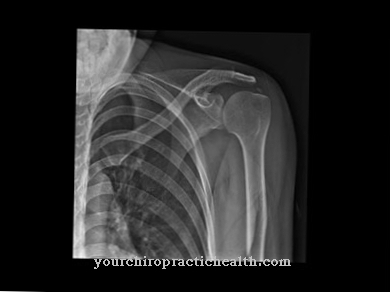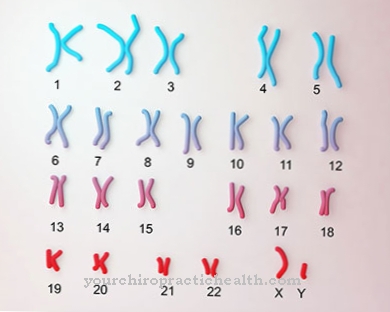Sarcoid or Boeck's disease is a rare disease that manifests itself primarily through inflammatory granulomas (small nodules). Although all organs in the human body can be affected by sarcoid, the lymph nodes and lungs are more commonly affected. The exact cause of Boeck's disease is not yet sufficiently known, but various environmental factors are assumed.
What is sarcoid?
.jpg)
© peterschreiber.media - stock.adobe.com
The Sarcoid, also known in medical circles as Boeck's disease is known, belongs to the diseases that predominantly affect soft tissue structures due to the course form and the predominantly affected organ systems. In addition to the lung tissue and structures, the skin, the eyes, the bone system, other organs such as the spleen and liver, and the vital heart can also be affected by sarcoid. Some disease courses have shown that sarcoid also extends to the nerves and pancreas.
Sarcoid is characterized by the formation of nodule-like clusters of tissue that are delimited like foci. These accumulations of tissue and cells are also known as granulomas because, histologically, they have a misshapen surface. Sarcoid can be a special reaction of the immune system that manifests itself in a concentration of cellular defense elements. Sarcoid disease is mainly observed between the ages of 20 and 40 years.
causes
First, base the causes for that Sarcoid, also known as granulomatosis, only on guesswork, because the disease itself and the functioning of the human immune system have not yet been adequately researched. In addition to the immune-controlled activities of the body, it is believed that sarcoidosis is genetic. Different environmental factors may also contribute to the development of sarcoid.
Symptoms, ailments & signs
The symptoms of a sarcoid depend on the organ system affected, and those affected often remain completely symptom-free. As a rule, the disease appears in a creeping, chronic form: its unspecific signs include general malaise, joint pain and weight loss, and the body temperature can be slightly increased.
Symptoms of the frequently occurring pulmonary sarcoidosis can be stress-dependent shortness of breath and chronic irritable cough, swelling of the lymph nodes in the chest is often only discovered by chance during an X-ray examination. If Boeck's disease affects the eyes, inflammation of the iris typically develops, which is associated with photophobia and eye pain.
Skin involvement is noticeable through characteristic skin changes: Typical of a nodular rose is the extremely painful nodule formation in the subcutaneous fatty tissue associated with reddening of the skin, mainly on the lower legs. Bluish-purple skin discoloration (lupus pernio) on the face also occurs.
A pronounced involvement of the heart often results in cardiac arrhythmias that require treatment or cardiac insufficiency, while sarcoid in the kidneys promotes the excretion of calcium and thus the formation of urinary stones. Neurosarcoidosis rarely occurs in the form of meningitis or paralysis of the facial muscles (facial paralysis).
Acute sarcoid is characterized by a sudden onset with fever and severe fatigue, typically accompanied by skin changes described as nodular rose, joint inflammation in the ankle and swelling of the lymph nodes in the lungs.
Bluish-purple skin discoloration (lupus pernio) on the face also occurs. A pronounced involvement of the heart often results in cardiac arrhythmias that require treatment or cardiac insufficiency, while sarcoid in the kidneys promotes the excretion of calcium and thus the formation of urinary stones. Neurosarcoidosis rarely occurs in the form of meningitis or paralysis of the facial muscles (facial paralysis).
Course of disease
A acute sarcoid can be started by the sudden onset of fever and general symptoms of infection. These common symptoms are tiredness, severe exhaustion, loss of appetite and aching limbs. Granulomatosis can only be definitively diagnosed through specific clinical pictures that occur in the affected organs. Heart and respiratory problems, impaired digestion and immune defense as well as changes in the blood count and altered liver values indicate the existence of sarcoid.
In addition to the acute form, the chronic sarcoid rather recognized by their creeping course. Some patients suffer from sarcoid and show no symptoms. In the context of a possible restriction of the respiratory and lung function, an accumulation of the granulomas can often be diagnosed by evaluating an X-ray image. This is a clear indication of sarcoid. Some of the nodules are so small that they can only be seen individually under microscopic magnification. Some of them can also be found in the lymph nodes. In addition, joint pain of the ankle, hematoma-like spots on the lower legs and inflammation of the iris are clear signs.
Complications
Chronic sarcoid can cause various complications as the disease progresses. The individual complaints that occur depend on which organ is affected. In the area of the lungs, Boeck's disease can trigger pulmonary fibrosis, in the course of which there are changes in the heart and ultimately right heart failure.
The formation of nodules in the area of the kidneys leads to renal insufficiency and, as a result, damage to the kidney tissue, cardiac arrhythmias and disorders of bone metabolism. If the eyes are affected, visual disturbances occur in the course of sarcoidosis and complete blindness can occur. Furthermore, the chronic form of the disease can lead to permanent paralysis, spleen diseases, skin damage and other complications.
Acute sarcoid usually does not result in long-term symptoms. Side effects are possible when treating both forms. The cortisone preparations prescribed when the eyes, liver, skin, heart and nerves are affected, for example, can lead to nerve damage and gastrointestinal complaints. Anti-inflammatory and pain reliever medications also carry corresponding risks. Physically weakened people and patients who are already taking other drugs are particularly at risk. However, serious complications do not usually occur.
You can find your medication here
➔ Medicines for fever and chillsWhen should you go to the doctor?
Symptoms such as muscle and body aches, fever, and a general feeling of illness can indicate sarcoid. A doctor's visit is indicated if the symptoms persist for several days or even become more intense. If the typical nodules appear on the mucous membrane, a doctor must be called in. If the symptoms arise after inhaling chemicals, fine dust, bacteria, fungi or allergenic substances, it is best to see your doctor immediately. People with lung diseases are also among the risk groups and should consult a doctor if the symptoms described occur.
In addition to the family doctor, the symptoms can be taken to a pulmonologist or a dermatologist, depending on the symptoms and the location of the nodules. Children should be presented to the pediatrician immediately if breathing difficulties or skin and mucous membrane changes occur. Boeck's disease requires comprehensive treatment that must be closely monitored. The doctor must be informed about symptoms and complaints as well as any side effects caused by the prescribed medication in order to rule out complications.
Treatment and therapy
The basis of treating a Sarcoid are drugs. These are mainly needed in the chronic course, acute sarcoid usually hardly needs any treatment. In addition to drugs for lowering fever temperatures, conventional medical practitioners have at their disposal substances that suppress inflammatory processes in the body. Since granulomatosis has painful impairments that resemble arthritis in the joints, painkillers are administered. So-called non-steroidal substances have proven themselves in this context. These are known as acetylsalicylic acid and ibuprofen.
Therapy is always based on the individual characteristics of the disease and the impairment of other organs. If the granulomas appear on the eyes, nerves and kidneys, the highly effective cortisone is used. The good effect of the cortisone is that the strong immunological activities are slowed down. If cortisone is poorly or not at all tolerated, then the doctor can also prescribe methotextran or azathioprim.
Aftercare
Decisive for the follow-up care of sarcoidosis (Boeck's disease) are its course (acute or chronic) and the severity of the symptoms. In the case of the acute form (30 percent of cases), follow-up care includes the continuation of the therapeutically initiated measures until the disease has healed. Sarcoid heals completely in around 95 percent of acutely ill people. The nodules resolve spontaneously within a few months.
Until the acute illness has healed, regular visits to a general practitioner or pulmonologist may be necessary. In the remaining five percent of acute sarcoid cases, those affected die. The aftercare then focuses on the therapeutic treatment of the bereaved. In order to cope with the grief, psychotherapeutic advice is generally recommended by a doctor for the bereaved.
In the chronic course of sarcoid (70 percent of cases), depending on the severity of the disease, the function of the lungs remains permanently restricted in 20 to 30 percent of the sick. Follow-up care here focuses on damage to the lungs. Regular pulmonary function tests are therefore urgently needed, also in order to detect a possible deterioration in pulmonary function at an early stage and also treat it in good time.
In addition, appropriate rehabilitation measures and endurance sports can improve lung function in individual cases. For rehabilitation measures, clinics located by the sea are recommended.
You can do that yourself
Although the cause of the disease has not been fully clarified to this day, the results of various studies and the course of the disease show the first indications that the immune system is involved. Therefore, in the area of self-help, the body's own defense system should be strengthened.
Sufficient exercise, a healthy diet rich in vitamins and good sleep hygiene promote the activity of the organism. The possibilities of movement are to be checked in such a way that no situation of excessive demands arises. Eating fresh foods and avoiding unhealthy meals can go a long way towards improving your wellbeing. The consumption of alcohol and nicotine should generally be avoided. Stays in the fresh air and adequate rest are also advisable. If symptoms arise, periods of rest should be taken. Sleep hygiene should be checked at regular intervals and, if possible, optimized. Attention should be paid to an appropriate room temperature, optimal sleeping utensils and the avoidance of disturbing noises.
In everyday life, stress and hectic rush should be reduced to a minimum. Long-term studies have shown that these have been shown to weaken the human organism and thus the immune system. When reading, writing or watching TV, make sure you have the right lighting. Many patients complain of eye pain and exposure to light that is too bright.


.jpg)

.jpg)
.jpg)





















